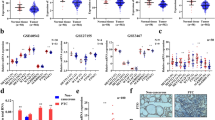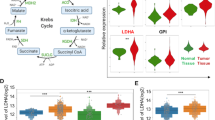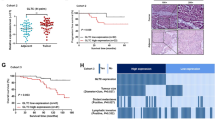Abstract
Recurring evidence suggests that fasting has extensive antitumor effects in various cancers, including papillary thyroid carcinoma (PTC). However, the underlying mechanism of this relationship with PTC is unknown. In this study, we study the effect of fasting on glycolysis and mitochondrial function in PTC. We find that fasting impairs glycolysis and reduces mitochondrial dysfunction in vitro and in vivo and also fasting in vitro and fasting mimicking diets (FMD) in vivo significantly increase the expression of lncRNA-protein kinase C theta antisense RNA 1 (PRKCQ-AS1), during the inhibition of TPC cell glycolysis and mitochondrial function. Moreover, lncRNA PRKCQ-AS1 was significantly lower in PTC tissues and cells. In addition, PRKCQ-AS1 overexpression increased PTC cell glycolysis and mitochondrial function; PRKCQ-AS1 knockdown has the opposite effect. On further mechanistic analysis, we identified that PRKCQ-AS1 physically interacts with IGF2BPs and enhances protein arginine methyltransferases 7 (PRMT7) mRNA, which is the key player in regulating glycolysis and mitochondrial function in PTC. Hence, PRKCQ-AS1 inhibits tumor growth while regulating glycolysis and mitochondrial functions via IGF2BPs/PRMT7 signaling. These results indicate that lncRNA PRKCQ-AS1 is a key downstream target of fasting and is involved in PTC metabolic reprogramming. Further, the PRKCQ-AS1/IGF2BPs/PRMT7 axis is an ideal therapeutic target for PTC diagnosis and treatment.
Similar content being viewed by others
Introduction
Papillary thyroid carcinoma (PTC) is the most prevalent type of thyroid carcinoma, which is a common type of cancer with a high incidence rate among women [1, 2]. Prognosis for PTC has remained at ten years with the application of traditional surgical treatment options [3]. Consistent recurrence and metastasis necessitate the identification of new potential biological markers for PTC.
Calorie restriction (CR) has recently attracted a lot of attention due to its role in cancer treatment [4, 5]. Fasting mimicking diets (FMD) is a less aggressive type of CR [6,7,8], which have been considered as a treatment strategy in conjugation with chemotherapy [9]. During tumorigenesis, cells become more dependent on aerobic glycolysis rather than mitochondrial oxidative phosphorylation, allowing them to meet the energy and nutrient demands of actively proliferating cancer cells. Studies have indicated that FMD changes this dependency on glycolysis and decreases the proliferation of cancer cells, thus making FMD a potential treatment strategy for cancer [10, 11]. However, no study has been published to date on the underlying molecular effects of FMD on PTC.
Long non-coding RNA (lncRNA), a group of non-coding RNAs of approximately 200 bp length, interact with other RNAs or proteins and play important roles in transcriptional, post-transcriptional regulation and chromatin remodeling [12,13,14]. Previously, studies have identified dysregulation of lncRNA-protein kinase C theta antisense RNA 1 (PRKCQ-AS1) to be associated with cancer progression, including colorectal cancer, triple-negative breast cancer [15,16,17]. In the initial phase of the investigation, we accessed the Gene Expression Omnibus (GEO) database (GSE3678 and GSE3467) and observed that the expression of PRKCQ-AS1 in PTC is significantly diminished in the tissue adjacent to carcinoma. A recent study found that the PRKCQ-AS1 is highly upregulated in colorectal cancer patients [15], leading to an increase in proliferation and migration of CRC cells. However, there are no studies till date of lncRNA-PRKCQ-AS1’s role in PTC.
Insulin-like growth factor 2 binding proteins (IGF2BP 1, 2, and 3) are a family of evolutionarily conserved RNA-binding proteins known to be involved in many cellular processes such as proliferation, differentiation, migration, polarization, and metabolism [18]. Structurally, IGF2BP1, 2, and 3 appear similar to each other in the placement of the domains, with a molecular weight between 58 to 66 kDa [19]. With around 56% amino acid sequence similarity among the protein domains, they share at N-terminal two RNA-recognition motifs (RRMs) and four hnRNPK homology (KH) domains in the C-terminal. Studies based on in vitro flag tagged proteins have identified specifically IGF2BP1 binds to over 1000 mRNAs [20]. In many cancer types, IGF2BPs is identified to be highly expressed [21,22,23,24], however relatively less is known about its molecular and regulatory role in PTC.
Protein arginine methyltransferases (PRMTs) family of proteins catalyze the methyl transfer to arginine residues of protein substrates and have been linked to many types of cancer [25]. PRMT7 is one of PRMTs that could only catalyze formation of monomethyl arginine (Rme1) [26]. PRMT7 has been identified to play vital roles in breast and lung cancer by regulating metastasis and EMT transition [Full size image
PRKCQ-AS1 regulates glycolysis and mitochondrial dysfunction of PTC through targeting IGF2BPs in vitro
Assessment of IGF2BPs levels in PTC cell lines indicated that TPC-1 had the least level of IGF2BP3 while K1 had the highest IGF2BP2 and there is no difference in IGF2BP1 (Figs. 5A and S5C). So, we focused on IGF2BP2 and IGF2BP3 for subsequent experiments. Moreover, the transfection efficiency experiments confirmed that IGF2BP2/3 overexpression has higher IGF2BP2/3 expression levels, IGF2BP2/3 knockdown has lower expression levels (Fig. S6A). Cell population analysis indicated that overexpression of IGF2BP2 moved a huge population of cells to S phase, whereas overexpression of IGF2BP3 moved cells to G1 phase. Silencing of IGF2BP2/3 resulted in the opposite (Fig. S6B). Further to understand the dynamic interactions between PRKCQ-AS1 and IGF2BP2/3, we silenced PRKCQ-AS1 and overexpressed either IGF2BP2 or IGF2BP3 in PTC-1 and K1 cells. In IGF2BP2 overexpressing-PTC-1 cells, cell proliferation, colony formation unit, glucose uptake, lactate production, ECAR, glycolytic enzyme levels and ROS production increased, whereas OCR and mitochondrial ATP production significantly decreased, which was further augmented by PRKCQ-AS1 knockdown (Figs. 5B–I and S2C, left). Additionally, in IGF2BP3 overexpressing-K1 cells, all of these indicators were opposite, and reversed by PRKCQ-AS1 knockdown (Figs. 5B–I and S2C, right). Overexpression of IGF2BP2 significantly increased JC-1 mitochondrial monomers with fragmented mitochondrial structures and fission protein level in PTC-1 cells, while overexpression of IGF2BP3 increased mitochondrial aggregates with elongated mitochondrial structures and fusion protein level in K1 cells. However, this increase in aggregates, elongated structures, and fusion protein level were reversed by the silencing of PRKCQ-AS1 (Fig. 5J–L). All these results indicated that silencing of PRKCQ-AS1 enhanced the effects of IGF2BP2 overexpressing and reversed the effects of IGF2BP3 overexpressing confirmed that indeed PRKCQ-AS1 regulates glycolysis and mitochondrial dysfunction of PTC through targeting IGF2BPs.
A The mRNA and protein expressions of IGF2BPs were detected by qRT-PCR and western blot in PTC cells. B–L PTC-1 cells were co-transfecred with sh-NC/sh-PRKCQ-AS1 and Vector/IGF2BP2; while K1 cells were co-transfecred with sh-NC/sh-PRKCQ-AS1 and Vector/IGF2BP3. B, C Cell proliferation was determined by CCK8 assay and colony formation assay in PTC-1 and K1 cells. D–G Glucose uptake, lactate production, ECAR and OCR were examined in PTC-1 and K1 cells. H Glycolysis associated proteins (PDK1, LDHA, HK2, GLUT1, and GPI) were determined by western blot. I Mitochondrial ROS and ATP production were observed. J JC-1 staining was used to observe mitochondrial membrane potential. Scale bar, 50 μm. K The proportion of cells with elongated, intermediate and fragmented mitochondrial was quantified. Scale bar, 10 μm. L Western blot and qRT-PCR analysis for protein expression levels of MFN1, MFN2, OPA1, DRP1, FIS1, and MFF. *P < 0.05, **P < 0.01, and ***P < 0.001.
PRKCQ-AS1 facilitates PRMT7 expression via interacting with IGF2BPs
To further understand the mechanism of regulating glycolysis and mitochondrial function, we assessed potential targets of IGF2BPs. Interestingly, we found a family of protein arginine methyltransferases (PRMTs) to be potential targets of IGF2BPs. It has been reported that IGFBP2 stabilizes PRMT6 mRNA [Full size image







